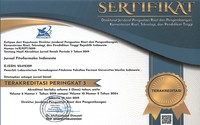Aktivitas Penghambatan Enzim α-Glukosidase Senyawa β-Sitosterol dari Fraksi Etil Asetat Daun Salam [Syzygium polyanthum (Wight.) Walp
Abstract
Keywords
Full Text:
PDF (Bahasa Indonesia)References
Alvionitasari, D. N. et al. (2021) ‘Prosiding Seminar Nasional Kimia Dan Terapan 2021 Isbn 978-602-50942-6-2 Isolasi Dan Identifikasi Senyawa Kimia Penghambat Enzim - Glukosidase Dari Fraksi Air Daun Salam ( Syzygium Polyanthum Prosiding Seminar Nasional Kimia Dan Terapan 2021’, (Dm), pp. 16–22.
Alwie, R. R. et al. (2021) ‘Aktivitas Ekstrak Etanol Daun Salam [Syzygium polyanthum (Wight) Walp.] Sebagai Penghambat Enzim Α-Glukosidase Dan Studi Secara In Silico’, Jurnal Fitofarmaka Indonesia, 8(2), pp. 36–42. doi: 10.33096/jffi.v8i2.750.
Dewijanti, I. et al. (2020) ‘Short Communication: Effects of the Various Source Areas of Indonesian Bay Leaves (Syzygium polyanthum) on Chemical Content and Antidiabetic Activity’, Biodiversitas Journal of Biological Diversity, 21(3), pp. 1190–1195. doi: 10.13057/biodiv/d210345.
Habibi, A. I., Firmansyah, R. A. and Setyawati, S. M. (2018) ‘Skrining Fitokimia Ekstrak n-Heksan Korteks Batang Salam (Syzygium polyanthum)’, Indonesian Journal of Chemical Science, 7(1), pp. 1–4.
Harismah, K. and Chuniatun (2016) ‘Pemanfaatan Daun Salam (Eugenia Polyantha) Sebagai Obat Herbal Dan Rempah Penyedap Makanan’, Warta LPM, 19(2), pp. 110–118.
Hidayah, N. et al. (2018) ‘Uji Efektifitas Antihiperurisemia Ekstrak Daun Salam (Syzygium polyanthum Wight.) Terhadap Mencit Jantan yang Diinduksi Jus Hati Ayam dan Kalium Oksonat’, Jurnal Saintika, 18(1), pp. 24–31.
Hikmah, N., Yuliet and Khildah, K. (2016) ‘Pengaruh Pemberian Ekstrak Daun Salam ( Syzygium Polyanthum Wight .) Terhadap Glibenklamid Dalam Menurunkan Kadar Diinduksi Aloksan The Impact Of Administration Bay Leaf Extract ( Syzygium Polyanthum Wight .) On Glibenclamide In Lowering Blood G’, 2(1), pp. 24–30.
Kazi, A. A. and Blonde, L. (2019) Classification of diabetes mellitus, Clinics in Laboratory Medicine. doi: 10.5005/jp/books/12855_84.
Kumar, S. et al. (2011) ‘α-glucosidase inhibitors from plants: A natural approach to treat diabetes’, Pharmacognosy Reviews, 5(9), pp. 19–29. doi: 10.4103/0973-7847.79096.
Lelono, R. A. A. and Tachibana, S. (2013) ‘Preliminary Studies of Indonesian Eugenia polyantha Leaf Extracts as Inhibitors of Key Enzymes for Type 2 Diabetes’, Journal of Medical Science, 13(2), pp. 103–110. doi: 10.3923/jms.2013.103.110.
Prianti, N. P. and Ellin, F. (2013) ‘Review Artikel: Tinjauan Aktivitas Farmakologi Ekstrak Daun Salam (Syzygium Polyanthum (Wight.) Walp)’, Farmaka, 16, pp. 288–297.
Sulastri, L. et al. (2022) ‘Antidiabetic Formulation Development Based on Natural Materials As α-Glucosidase Enzyme Inhibitor’, Journal of Hunan University Natural Sciences, 49(1), pp. 228–238. doi: 10.55463/issn.1674-2974.49.1.29.
Tukiran et al. (2016) ‘Analisis Awal Fitokimia Pada Ekstrak Metanol Kulit Batang Tumbuhan Syzygium ( Myrtaceae ) Phytochemical Analysis Of Methanol Extract Of Syzygium Stem Barks ( Myrtaceae )’, Prosiding Seminar Nasional Kimia dan Workshop, (September), pp. 1–7.
Widjajakusuma, E. C. et al. (2019) ‘Phytochemical screening and preliminary clinical trials of the aqueous extract mixture of Andrographis paniculata (Burm. f.) Wall. ex Nees and Syzygium polyanthum (Wight.) Walp leaves in metformin treated patients with type 2 diabetes’, Phytomedicine, 55(1), pp. 137–147. doi: 10.1016/j.phymed.2018.07.002.
DOI: https://doi.org/10.33096/jffi.v11i1.981
Copyright (c) 2024 Lilik Sulastri

This work is licensed under a Creative Commons Attribution-ShareAlike 4.0 International License.
Indexed by:
ISSN: 2356-0398 | e-ISSN: 2541-2329
Editor's Address:
Third Floor Pharmacognosy-phytochemistry laboratory building, Urip Sumoharjo road km. 5 Campus II UMI, Makassar, South Sulawesi, Indonesia
Phone: +6281524045514
Fax: +62411425619
E-mail: editorjfi@umi.ac.id

















.jpg)

